There are TONS of terms and acronyms in education! And when it comes to literacy instruction, there’s no shortage.
For example, you may have heard of these 3:
- Read-aloud
- Shared Reading
- Guided Reading
They kinda sound the same, right? But they’re not!
There are subtle — but important — differences among these 3 instructional practices.
Each instructional practice can help your students grow in a different way. When you understand the differences, you can better utilize them to help your students become stronger readers!
In today’s post, I’ll explain the differences through some simple, easy-to-read charts!
Whether you’ve been teaching for 10 weeks or 10 years, it’s always helpful to revisit these concepts and reflect on your teaching!
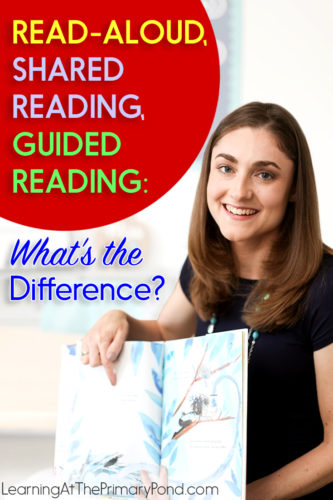
I think it’s helpful to compare these instructional routines in a few areas:
- Timeframe (how long they take to implement)
- Skills to address
- The teacher’s role
- The students’ role
- Text difficulty
Let’s look at each area individually:
Timeframe
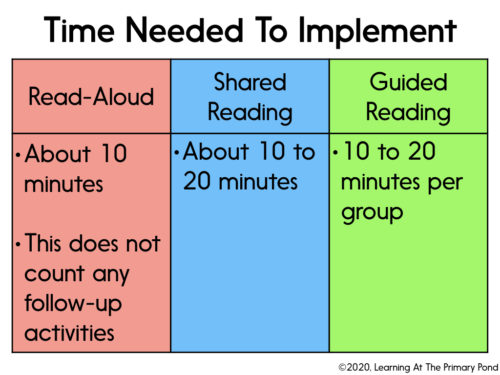
In a nutshell, a read-aloud typically takes the least amount of time (because you’re doing most of the work).
Always pay attention to your students’ attention spans and adjust accordingly!
Skills to Cover
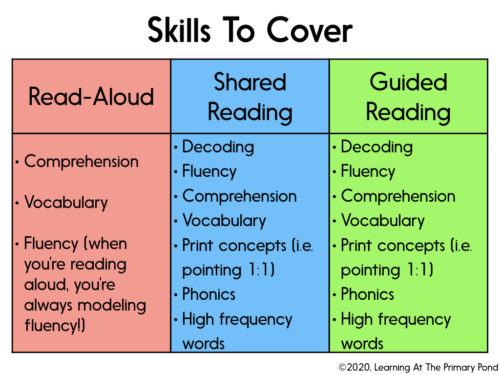
To sum it up, read-alouds are great for working on skills that don’t require students to be able to see and read the text.
With a read-aloud, you can engage students in higher-level thinking. By reading aloud, you’re giving students access to more challenging text (that they often can’t yet read on their own).
Shared reading and guided reading are great for working on all skills. They’re “closer” to independent reading, so you’re getting students ready to use these same strategies on their own.
Teacher’s Role
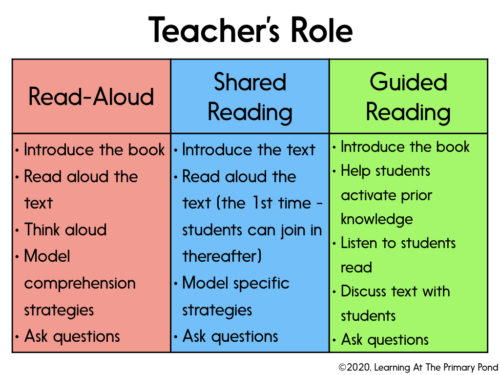
Out of these 3 instructional practices, the teacher does the most work during a read-aloud. She does the least work during guided reading. Shared reading falls somewhere in between.
Students’ Role
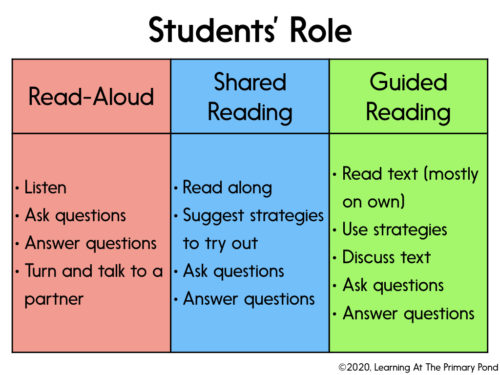
Out of these 3 instructional practices, the students do the least actual reading during a read-aloud (their job is not to decode, but simply to listen and comprehend). They do the most work during guided reading, as they should be reading the vast majority of the text. Shared reading falls somewhere in between, as the teacher and students share the work of decoding and comprehending the text.
Text Difficulty
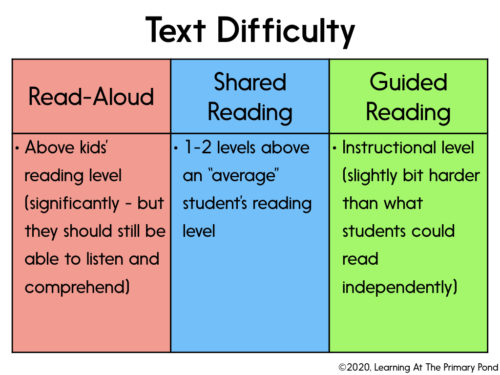
Together, these 3 practices give kids opportunities to work with texts at a variety of levels.
Learn More
If you’d like to learn more about these instructional practices, grab one (or both!) of these freebies:
Free Shared Reading / Reading Workshop Lesson Plans
You can also check out these additional posts that go more in-depth:
What Is Shared Reading, and Why Is It So Important?
3 Reasons Why It’s Okay to Do a Readaloud (Just for the Sake of Doing a Readaloud)
Happy teaching!

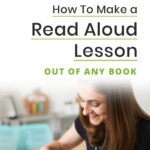

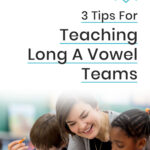
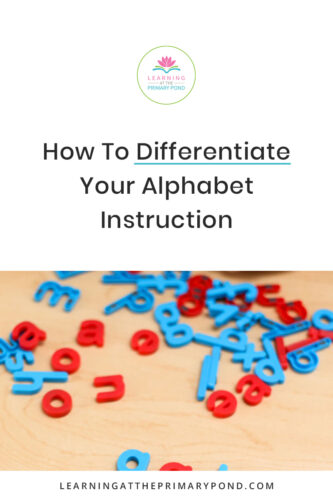








Love me some color-coded charts! Thank you for the clear, easy reference!
You’re so welcome! I’m glad it’s helpful!
This is a good amount of clarity between the 3 concepts. The colour coding of the charts makes it more striking. However just one question – what type of reading strategies will one be sharing in all three.
Hi there! It depends on the level of your students – it could be anything from “Make your voice match the punctuation marks” to “Monitor your own comprehension and re-read as necessary” to “Break words into syllables to read them.”
The charts make it so easy to grasp those practices and figure out what to use for students. Would it be possible to use the charts for my ESL class as a reference to help teachers learn how to teach reading?
Hey Tenya! Yes, that is completely fine for you to use the charts for a reference! 🙂
Hi Alison,
I just watched your video regarding the reading workshop. It was very informative and helpful. I was very inspired, and It is very impressive. I really appreciate the simplistic way you explained everything. Thank you your time and effort and for sharing it.
Wonderful, Amado!!
May I use your slides to show my new teachers?
Of course!
https://learningattheprimarypond.com/blog/read-aloud-shared-reading-guided-reading-whats-the-difference/ this is a good article, thanks
You’re welcome!